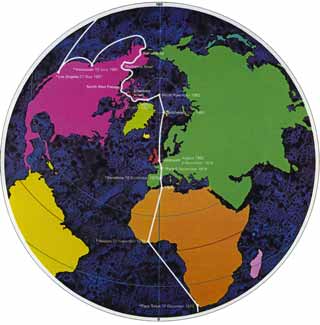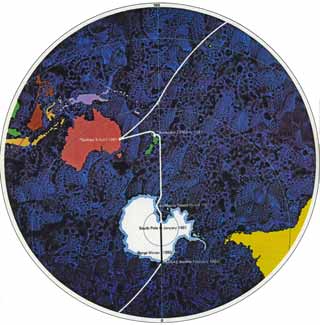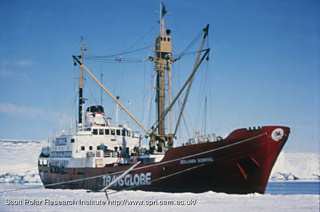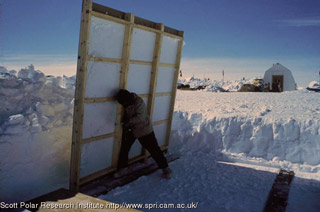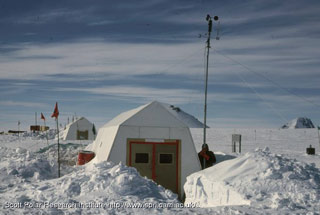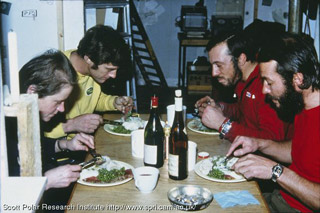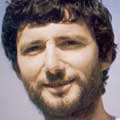The Transglobe Expedition
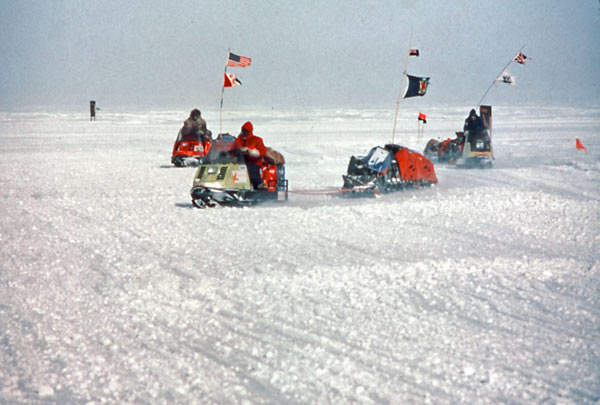
The British team arrives at Pole on 15 December 1981 (CH)
|
The Transglobe Expedition was the first of many unusual ventures planned (and usually completed successfully) by British adventurer Sir Ranulph Fiennes. Ran, who was born in 1944, got started with extreme and unusual exploits during his eight years as a British Army officer, which included time with the SAS during which time he specialized in demolitions. His SAS career ended when he was cashiered for a scheme to blow up a dam (which had been built for the filming of Doctor Doolittle). Eventually he left the Army and turned to adventurous exploits. In February 1972, his wife Ginnie first suggested a surface round-the-world expedition following the Greenwich meridian (and the International Date Line) around the globe. Planning and training for this venture began in February 1975; over the next several years there would be equipment testing, personnel selection, and additional training on the Greenland icecap, as well as a 960-mile journey from northern Ellesmere Island toward the North Pole. The original expedition team consisted of Ran, Charles (Charlie) Burton, and Oliver (Ollie) Shepard, and other significant participants included Virginia (Ginnie) Fiennes (Ran's wife), and pilot Giles Kershaw. | ||
|
Above is the originally planned expedition map and schedule, from the official Transglobe expedition booklet. The actual dates and routes were slightly different, particularly at the end, when an early breakup prevented their travel to Spitsbergen and they ended up riding an ice floe south.
As is obvious from the above maps, much of the trip was ocean travel, and for this they used the Benjamin Bowring, a 213-foot vessel with a displacement of 1,250 deadweight tons and a draft of 19'-9" when fully loaded. This ship had originally been commissioned as the Kista Dan in 1952, and its first Antarctic mission had been to support the filming of Hell Below Zero, a 1954 film based on Hammond Innes' novel The White South. Later it was chartered to support ANARE as well as BAS. For the expedition, the ship was renamed to honor the founder of its sponsor, the C. T. Bowring insurance brokers. The venture left London on 2 September 1979. The first part of the trip was simple enough--a drive through France and Spain, followed by a trip south through western Africa, which was much more peaceful in those days. They then rejoined the ship and voyaged to South Africa...leaving for the ice on 22 December. Meanwhile, Giles Kershaw, with engineer Gerrard (Gerry) Nicholson, were making their way in the Twin Otter. From the UK they flew first to Toronto, and then south from Toronto through South America to the Falklands. From there they headed to Faraday where they airdropped mail before proceeding to Rothera, Halley, and Sanae. The ship left on 17 January; meanwhile construction continued at the winter base site, which had been named Ryvingen for the peak just to the east. The base was at 72º55'S-3º29'W, about 180 miles inland from the then-new Sanae III, at an altitude of 5,600 feet. The ice party left Sanae on 25 January for Borga on their snowmobiles as construction of the insulated cardboard huts continued, as did the cargo flights. After some difficulty with crevasses, they reached the hut site several days later. The 78 cargo ferrying flights were completed on 10 February, and Giles and Gerry left the ice party shortly afterward, retracing their flight path to Canada and leaving the ice party alone for the winter. They had four huts--a main living hut 36 feet long, a generator hut 80 feet away, a radio hut 160 feet further away, and a VLF hut 1/2 mile away from the main camp site. The huts were prefabricated from insulated Triwall cardboard, bolted to light floor boards...they quickly became buried, and tunnels were dug for storage and access. Charlie Burton (cook, electrician, mechanic, and radio operator) and Oliver Shepard (mechanic, medic, met, and radio operator for the Antarctic crossing) shared one room in the main hut, Ran (the leader) and Ginnie (comms and VLF program) shared the other berthing room, and Bothy, a long-haired Jack Russell terrier, lived wherever. Two other members of the expedition support team, Simon Grimes and Anthony (Anto) Birbeck, wintered at a separate camp (Fimbulisen, named for the Fimbul Ice Shelf on which it rested) a few miles from Sanae. They visited the South African base about once a month. | ||
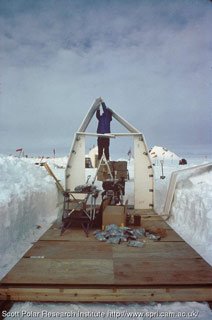 The next step...erection of the cardboard wall and roof panels (SPRI). |
||
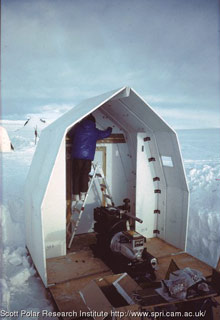 Simon Grimes continues with hut assembly--This looks like the generator hut...the expedition relied on a 10 kva diesel generator (seen here) to power the 1 kw radio. There were also two 1.5 KVA Allam generators for everyday use (SPRI). Here's another hut construction photo. |
||
|
The VLF antenna--part of a scientific program developed with assistance from Sir Vivian Fuchs--was 1/2 mile from the VLF hut. Other scientific programs included glaciology, met records, accurate altimetry during the crossing, and medical and dental studies. At the beginning of the winter isolation, the team was busy digging the tunnels for storage and hut access...their total length was about 200 yards, and of course one of them housed the loo. The berths were elevated near the roof of the main hut...while the temperature at floor level might be 5ºF, the temperature at the bed level would be 36ºF...unless the stove went out.
After the tunnels were done and rope lines were established between the huts, some of the free time was spent training for the continental crossing, including practice at celestial navigation as well as ski training trips while the twilight lasted. Ginnie kept adjusting and reworking the antennas to improve communications, and handled the VLF science project. The coldest winter temperature at Ryvingen was -49.9ºF in July. There were some problems...including several small fires (remember that the huts were cardboard), some issues with carbon monoxide, and a few fairly serious frostbite incidents. In July, the large generator developed an unrepairable hole in the crankcase. There were some of the interpersonal issues not uncommon with small wintering groups. And Ran had to deal with some of the expedition management issues from afar--including finding a replacement pilot for Giles Kershaw for the second part of the Arctic portion of the expedition, replacing some of the ship's company, and learning that Ollie would leave the venture after Antarctica because of his wife's insistence. As a result, the decision was made for the Arctic crossing to be two people (Ran and Charlie), and this caused a bit of concern with the expedition committee in London as well as the media in general. The sun returned on 5 August, and preparations for departure ramped up, as the weather stayed cold. The team saw the temperature hit -58ºF a week before departure, as Giles was making his way south from the Northern Hemisphere. He arrived on 28 October, bringing Simon Grimes from Sanae...and on the 29th, Ran, Charlie and Ollie headed south for Pole, about 1200 miles away. Each of the three snowmobiles was pulling a 12-foot metal sledge loaded with about 1,500 pounds of cargo. The journey developed into a mundane routine. Typically the 3 snowmobiles traveled about a mile apart. They kept weather records, and every degree of latitude they took 2-meter snow samples (which they melted and stored). They encountered mechanical problems with the snowmobiles and sleds, rough sastrugi, and the occasional crevasse. Giles made many flights south to establish fuel depots for the team. And Ran had continual administrative issues to deal with via radio back to Ginnie at Ryvingen...the biggest of these involved negotiations for Giles to be able to refuel at Pole--fuel supplies were critical, in part because some fuel drums were lost when a storm came up during the initial unloading at Sanae. The negotiations eventually succeeded, as a result of direct talks between the British Foreign Office and the U.S. State Department. And then another issue intervened. While the ice team was at about 85ºS awaiting a replacement for a broken snowmobile spring, when word came that a South African geological party of 12 had lost one of its tractors in a crevasse 85 miles south of Sanae...and that 3 members of the party had gone missing after attempting to return to the base by snowmobile...and one of the other 9 men had fallen into a crevasse and died while searching for the 3 missing men. Giles' Twin Otter was the only aircraft capable of conducting a search...and it was at 80ºS moving fuel for the Transglobe team. So after extreme difficulty starting his aircraft engines due to a cold nearly-dead battery, Giles flew to Pole, refueled (and recharged his battery) and flew back toward Sanae to search for the missing men. Meanwhile, the traverse party received the rest of the fuel needed to reach Pole...on 14 December the visibility was poor, but they got close enough to the station for radar to pick up their vehicles...and after getting a bearing, they reached Pole on 15 December, 3 weeks ahead of their original schedule. The rest of the story continues here...photo credits and notes are on the bottom of the following page. |
||
